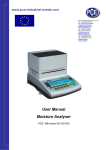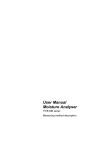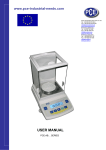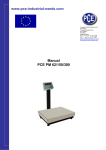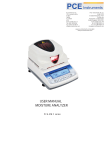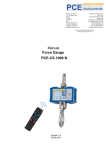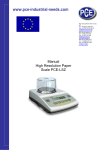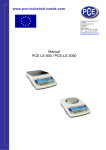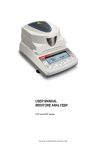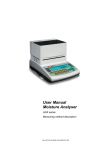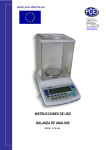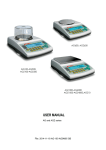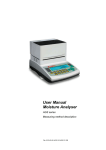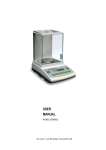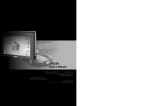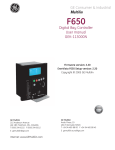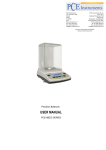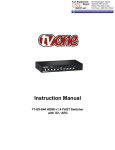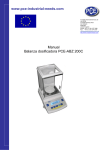Download User Manual Precision Balances
Transcript
PCE Americas Inc. 711 Commerce Way Suite 8 Jupiter FL-33458 USA From outside US: +1 Tel: (561) 320-9162 Fax: (561) 320-9176 [email protected] PCE Instruments UK Ltd. Units 12/13 Southpoint Business Park Ensign way Hampshire / Southampton United Kingdom, SO31 4RF From outside UK: +44 Tel: (0) 2380 98703 0 Fax: (0) 2380 98703 9 [email protected] www.pce-instruments.com/english www.pce-instruments.com User Manual Precision Balances PCE- MB series 50-100-200 Measuring method description USER MANUAL Contents: 1. 2. 3. 4. 5. 6. 7. 8. 9. 10. 10.1 10.2 10.3 10.4 10.5 10.6 10.7 10.8 10.9 11. 11.1 11.2 11.3 11.4 11.5 12. 13. 14. 14.1 14.2 14.3 14.4 14.5 14.6 15. 16. General description ______________________________________________________________ 3 Completeness __________________________________________________________________ 3 Security rules___________________________________________________________________ 4 Environment protection ___________________________________________________________ 5 Technical data __________________________________________________________________ 5 Keys and indicators ______________________________________________________________ 6 Preparing moisture analyser to work _________________________________________________ 7 Interfaces______________________________________________________________________ 9 General working rules ____________________________________________________________ 9 Description of thermogravimetric analysis____________________________________________ 9 Infrared radiation source ________________________________________________________ 10 Infrared radiation drying description _______________________________________________ 10 Drawing and preparation of a sample ______________________________________________ 11 Tools requirements ____________________________________________________________ 11 Single-use pans_______________________________________________________________ 12 Placing a sample ______________________________________________________________ 12 Glass fibre filter _______________________________________________________________ 12 Practical notes ________________________________________________________________ 12 Troubleshooting_______________________________________________________________ 13 Moisture analyser functioning description ___________________________________________ 14 Switching on _________________________________________________________________ 14 Description of parameters and working modes _______________________________________ 15 Working mode parameters setting_________________________________________________ 16 Initial moisture analysis _________________________________________________________ 17 Proper moisture analysis ________________________________________________________ 19 Connecting to a computer or a printer ______________________________________________ 20 Testing and calibration of the balance______________________________________________ 21 Moisture analyser as a balance___________________________________________________ 22 Autotare _____________________________________________________________________ 22 Balance calibration ____________________________________________________________ 23 RS-232C settings______________________________________________________________ 26 Printout parameters ____________________________________________________________ 27 Date and time setting___________________________________________________________ 28 User language ________________________________________________________________ 28 Troubleshooting_______________________________________________________________ 29 Maintenance and repairs of small defects ___________________________________________ 30 Declaration of Conformity __________________________________________________________ 31 Appendix – Drying parameters for different substances (examples) _____________________________ 32 2 USER MANUAL 1. General description MB series moisture analyser is destined for fast and precise moisture determination. The moisture analyser is based on two cooperating devices: the balance, used to measure current sample weight, and the dryer, which dries the sample using halogen heaters. Drying parameters may be set according to user preferences. Moisture analysers are mainly destined for use in quality control in food industry, building materials industry, biotechnology, pharmacy, environment protection and others. Moisture analysers may be also used as laboratory balances for routine weighing (without drying). 2. Completeness Standard package consists of: 1. Moisture analyser, 2. Pan shield, pan support, pan handle, 3. Single-use pans – 10 pcs, 4. Power supply cord, 5. User manual, 6. Guarantee card. 3 USER MANUAL 3. Security rules To avoid electrical shock or damage of the balance or connected peripheral devices, it is necessary to follow the security rules below. • Dryer chamber cover heats up to 40°C, but perforated cover at the top may heat up over 60°C. Do not touch the cover top during drying as it may cause severe burns! • During heating, the halogen heaters warm up to very high temperature. Avoid touching the heaters as it may cause severe burns! • All repairs and necessary regulations can be made by authorised personnel only. • Do not use the analyser when its cover is opened. • Do not use the analyser in explosive conditions. • Do not use the analyser in high humidity. • If the device seems not to operate properly, plug it out of the mains and do not use it until checked by authorised service. 4 USER MANUAL 4. Environment protection According to legal regulations it if forbidden to dispose wasted electronic equipment in waste containers. WEEE-Reg.-Nr. DE64249495 • Please return wasted device to the point of purchase or other company specialised in recycling of wasted electronic components. 5. Technical data Type Maximum sample weight Minimum sample weight Reading unit (d) Verification unit (e) Tare range Accuracy class Working temperature Analyser resolution Moisture measurement accuracy Max drying temperature Sampling time Maximum drying time Oven dryer power (halogen l=118mm) Warm-up time (100°C) Pan size Drying chamber dimensions Weight Device dimensions (with legs) Power Calibration weight (OIML) PCE-MB 50 50g 0,02g 1mg 0,01g - 50g PCE-MB 100 100g 0,02g 1mg 0,01g - 100g II +18 ÷ 33°C 0,01% for sample weight 0,1g÷5g .......... ±0,3% for sample weight 5g÷15g .......... ±0,06% for sample weight >15g ........... <±0,04% 160°C 1 ÷ 180s < 10h PCE-MB 200 200g 0,02g 1mg 0,01g - 200g 100W ~1min. φ90mm φ108x20mm 7kg 215(235)x345x200mm ~230V 50Hz 110VA F2 100g F2 50g 5 F2 200g USER MANUAL 6. Keys and indicators →T← I/ ENTER . 1/F1 2/F2 - 3/F3 4/F4 5/F5 6/→0← 7/ 8/ 9/Menu 0/ > < - ∧ ∨ indicator bar indicator indicator OFF Max, Min, d, e tare (subtract package weight from weighed mass) switch- on / switch-off (standby), confirmation / select the option decimal point, digit key 1 / START – start measurement (drying), digit key 2 / SETTINGS – moisture measurement parameters setting, digit key 3 / STAT – drying chart, measurement report, digit key 4 / BALANCE – weighing mode, digit key 5 / STOP – instant drying termination, digit key 6 / zeroing (optional) digit key 7 / printout (data transmission), digit key 8 / autocalibration (unused function), digit key 9 / enter the Menu digit key 0 / mode switching (analyser – balance) enter the option, leave the option, navigation / move the cursor up, - navigation / move the cursor down, - result stabilisation, total load indicator (0-100%), stand-by mode (when switched-off with I/ metrologic parameters. 6 , key), USER MANUAL 7. Preparing moisture analyser to work During heating, the halogen heaters 1 warm up to very high temperature. When drying chamber is opened avoid touching the heaters as it may cause severe burns or damage the heaters! Dryer chamber cover 3 heats up to 40°C, but perforated cover may heat up over 60°C. Do not touch the top cover during drying as it may cause severe burns! 1 2 3 7 6 5 4 8 10 9 1. Take all contents out of a package: the moisture analyser and packed separately: the tin pan shield, single use pans, the pan handle and the pan support. 2. Place the balance on a stable ground not affected by mechanical vibrations and airflows. 3. Level the balance with rotating legs 9 so that the air bubble in water-level 10 at the back of the balance is in the middle and the moisture analyser rests on all four legs. 4. Open the dryer chamber with the handle at the front. Put the pan shield 4 on three distance sleeves 8. Gently insert the pan support 5 into the mechanism hole. 7 USER MANUAL 5. Place a single use pan 7 on the pan handle 6 and put the pan on the pan support (the handle should rest on the pan shield so that it does not touch the pan or the pan support). 6. Close the drying chamber cover 3 and plug the device to the mains (230V). 7. After self-tests and result stabilisation zero indication is displayed. The dryer starts initial heating (signalised with an appropriate communicate). After initial heating the moisture analyser is ready to work. When temperature during initial heating exceeds 105°C or heating time is longer than 1 minute, terminate initial heating with CLR key and check if the temperature sensor 2 works properly and if both halogen heaters light 1 (see chapter 15). In case any defect occurs contact an authorised service point. 8. The balance should not be used to weigh ferromagnetic materials due to accuracy decrease. 8 USER MANUAL 8. Interfaces The moisture analyser is equipped with RS23C interface to connect a printer or a computer and with PS2 port to connect an external computer keyboard. 9. General working rules During transportation remove the pan, the pan support and the pan shield and place it in a separate package. 1. Distribute a sample all over the pan. A sample surface should not touch temperature sensor placed above the pan. 2. The balance is equipped with the tare equal to its range. To tare the balance press “T” key. Writing the tare does not extend measuring range, but only subtracts the tare value from a load placed on the pan. To make weight control easier and to avoid range overdrawing, the balance is equipped with weight indicator (graduated in percentages). 3. Do not overload the balance more then 20% of maximum load (Max). 4. The mechanism of the balance is a precise device sensitive to mechanical strokes and shocks. Do not press the pan with a hand. 10. Description of thermogravimetric analysis This section gives some practical details about moisture analysis using infrared radiation for reliable results and easier use of moisture analyser. The description is based on a pre-production experience and customers’ suggestions. Moisture in substances is an essential quality factor of technical and economical importance. 9 USER MANUAL Methods of determining moisture may be grouped in two main categories: absolute and deductive. Absolute methods are based on simple relations, e.g. weight decline during drying. Thermogravimetric analysis used in PCE moisture analyser is an example of this method. Deductive (indirect) methods measure physical quantity related with moisture, e.g. electromagnetic waves absorption, electrical conductance, acoustic wave speed. Some of these methods, unlike thermogravimetric analysis, enable to determine water content. Thermogravimetry - lat. thermo – heat, gravi – weight, metry – method Thermogravimetric analysis – a process of determination of a substance mass decline as a result of heat-up. The sample is weighed before and after heating-up, the difference is calculated in relation to initial weight or final weight (dry mass). Moisture in substances Thermogravimetric analysis includes all ingredients evaporating from substances during heating-up, which results in weight decrease. In result of the above, determining of moisture content in substances is not equal water content. Beside water, moisture consists of all other volatile matter: fats, alcohol, aromas, organic dissolvent and other substances resultant as en effect of thermal decomposition. Thermogravimetric analysis does not distinguish water from other volatile matters. Infrared radiation drying is more effective than traditional methods (e.g. in an oven) as the radiation deeply penetrates the substance, which shortens drying time. 10.1 Infrared radiation source MB series moisture analyser uses 2 halogen heaters (rated power 200W, l=118mm) in serial connection as a radiation source. The heaters emit also visible radiation, which does not affect drying process. 10.2 Infrared radiation drying description Sample drying is a result of absorption of infrared radiation, which results in sample temperature increase and evaporation of volatile matters. Infrared radiation penetrates surface layers, the depth depends on penetrability of a sample (different in various substances). Part of radiation is reflected by the sample surface. Penetrated layers absorb the radiation and convert its energy into heat. Emitted heat propagates inside the sample. Effectiveness of the propagation depends on thermal conductivity of the sample. The better the conductivity, the faster drying process and volatile matter evaporation. During drying process sample parameters change, its thermal conductivity decreases so there is a risk of burning the sample. Some parameters may be estimated “by sight”, e.g. smooth 10 USER MANUAL and light surfaces reflect radiation better. This must be taken into account when setting drying parameters. 10.3 Drawing and preparation of a sample As sample of given substance must be representative, drawing and preparing a sample is very important process as it affects repeatability of measurements. The most common method of homogenizing a sample is mixing. The other method is to draw few samples from different but specific points in a substance and calculate an average value. Another – to draw few samples from different points in a substance, mix them and draw a sample from the mixed samples. Sampling method depends on the object of a research. For quality purpose many representative samples are analysed. In production control it is enough to assure sampling repeatability, which enables to study a tendency. While preparing and drawing, it is important that the sample does not absorb moisture from the environment – it is advised that operation time is as short as possible. If it is necessary to analyse more than one sample at the same time, the samples should be closed in plastic bags or other isolated containers. Give attention that samples must not lose moisture inside the container (the container should not consist of to much air, the moisture condensed on the sides of the container should be mixed with the sample again). 10.4 Tools requirements Tools and instruments used in preparation process may affect measurement accuracy, so it is advised not to use tools that transmit heat, as it makes the sample lose moisture before analysis. Use only special mills and pestles. In case of liquids with consisting of solid materials use a glass mixer, a spoon or a magnetic mixer. 11 USER MANUAL 10.5 Single-use pans To analyse the moisture, put a sample on a single-use pan and place it in the dryer chamber. Using non-reusable pan helps to avoid false results by remains of previous samples. 10 single use pans are provided with the moisture analyser. Any quantity may be delivered on demand. 10.6 Placing a sample A sample should be placed uniformly all over the pan, so that heat propagates equally all over the sample and dries whole sample effectively and quickly without leaving “wet” places. Correct Incorrect Attention: Due to temperature sensor localisation, max sample height is 10mm. When substance ply is too thick, surface layers will be heated too much and internal – not enough. This may result in burning the sample or surface incrustation, which will make drying process difficult and measuring result false. A sample should be placed in uniformed layers 2÷5mm thick, weighing 5÷15g, depending on a substance. 10.7 Glass fibre filter When drying liquids, pastes or substances that may melt or loose liquid during drying, it is advised to use glass fibre filters. Filters ensure equal liquid distribution or, in case solid materials, avoiding burning a sample. 10.8 Practical notes Put a sample on the pan as quickly as possible to avoid losing moisture. Temperature inside the chamber is much higher than outside, so the sample may evaporate partly before measurement begins, which will result in a false result. 12 USER MANUAL When analysing the same substance quantity in successive measurements, use the same tools to put a sample to be sure that samples are each time of the same size. Before putting a sample, tare a single-use pan and take it out of the chamber. Right after putting a sample on the pan, place it inside the analyser chamber, close the chamber and press START. Be sure that no dirt sticks under the pan, as it may increase sample weight and result in false values. 10.9 Troubleshooting Problem Solution A sample burns down Reduce temperature Use glass fibre filter on the top of the sample Reduce sample quantity and distribute it uniformly Drying lasts too long Increase temperature Reduce sample mass A sample loses weight before measurement Take out the pan and put a sample outside the chamber A sample is liquid or paste Use glass fibre filter A sample does not consist of enough volatile matters Enlarge a sample 13 USER MANUAL 11. Moisture analyser functioning description 11.1 Switching on After switching-on the moisture analyser proceeds with self-tests. START-UP program version CPU test EEPROM read-out ... ... After completing self-tests, the analyser is tared and the dryer begins initial heating necessary to create thermal conditions suitable for measurements. m0-m/m0*100% Ts=120°C ts= 0:10:00s T= 32.23°C m=0.000g Ts=105°C INITIAL HEATING Initial heating should warm the drying chamber up to 105°C within 1 minute. When temperature during initial heating exceeds 105°C or heating time is longer than 1 minute, terminate initial heating with CLR key and check if the analyser is not damaged (see chapter 15). After initial heating is completed (or terminated), the device displays the following information: m0-m/m0*100% T = 32.23°C m= 0.000g t =0:00:00s m0= 0.000g START SET Ts=120°C ts= 0:10:00s 0.00 % STAT BALANCE STOP Legend: m0-m/m0*100% - formula used to calculate the moisture Ts – defined drying temperature ts – defined drying time T – current temperature in the drying chamber m – current weight, t – current drying time m0 – initial weight 14 USER MANUAL 11.2 Description of parameters and working modes Current value of moisture measurement is calculated and displayed during drying. The process is finished under one of the conditions below: 1. Evaporating is finished and successive weight measurements results (samples) do not differ. 2. User defined Drying time is finished. Ad.1 The number of successive samples that terminates drying process is called Qualifying quantity. It is advised to use 5 samples, but it is possible to use smaller qualifying quantity. Time interval between each weight sample (Sampling interval) may be adjusted according to drying rate. Ad.2 To terminate a measurement after defined Drying time, set Qualifying quantity: none. The moisture can be calculated basing on different mathematical formulas, used in the moisture analyser as Working modes: 1. Moisture is determined in relation to initial weight w [%] = m0-m/m0*100% , where m0 – initial weight, m- current weight 2. Moisture is determined in relation to current weight w [%] = m0-m/m*100% , 3. Current weight determined as a percentage of sample weight w [%] = m/m0*100% . Drying temperature is maximum temperature measured by the temperature sensor near dried sample. Pay attention that temperature of dried material may be higher than temperature of its surrounding. 15 USER MANUAL 11.3 Working mode parameters setting m0-m/m0*100% Ts=120°C T = 32.23°C m= 0.000g t =0:00:00s m0= 0.000g START SET F1 F2 ts= 0:10:00s 0.00 % Choose Settings option (SET) pressing F2 key. STAT BALANCE STOP F3 F4 F5 MOISTURE ANALYSER PARAMETERS 1. Working mode 2. Drying temp. 3. Qualified qty. 4. Sampling interval 5. Drying time 6. Exit : : : : : m0-m/m0*100% 60°C 2 samples 10s 0:00:10s Choose Working mode using ∧ and ∨ keys and press ENTER. ENTER MOISTURE ANALYSER PARAMETERS 1. Working mode 2. Drying temp. 3. Qualified qty. 4. Sampling interval 5. Drying time 6. Exit : : : : : m0-m/m0*100% 60°C 2 samples 10s 0:00:10s < > ENTER To leave settings menu choose Exit and press ENTER. MOISTURE ANALYSER PARAMETERS 1. Working mode 2. Drying temp. 3. Qualified qty. 4. Sampling interval 5. Drying time 6. Exit : : : : : Using <, > and digit keys (if necessary) choose desired drying parameters and press ENTER to accept. - Moisture calculation formula, - Qualified quantity (options: none, 2, 3, 4, 5), - Sampling interval (<180s.), - Drying time (< 10h) m0-m/m0*100% 60°C 2 samples 10s 0:00:10s ENTER Note: All defined parameters are stored in the memory until the next changed (also after unplugging the device from the mains). 16 USER MANUAL 11.4 Initial moisture analysis To estimate optimal drying parameters for unknown sample, it is advised to proceed with initial measurement necessary to make initial measurement with activated drying chart. For initial drying set the following parameter values (see Drying parameters setting): Temperature: - organic matters: 80 – 100°C - mineral matters: 140 – 160°C Qualifying quantity: none (drying process is stopped after defined drying time) Sampling interval: 1s Drying time: set the time value enough to dry the whole sample To display drying chart follow the instruction below: ms-ma/ms*100% Ts=120°C T = 32.23°C m= 0.000g t =0:00:00s m0= 0.000g START SET F1 F2 ts= 0:10:00s Choose STAT option with F3 key, select Drying chart and press ENTER. 0.00 % STAT BALANCE F3 F4 STOP F5 DRYING REPORT 1. Drying chart 2. Product name 3. Executive/done by… 4. Notes 5. Statistics Exit : : OFF Choose Drying chart using ∧ and ∨ keys and press ENTER. : : ENTER DRYING REPORT 1. Drying chart 2. Product name 3. Executive/done by… 4. Notes 5. Statistics Exit : : : ON Using < and > keys choose ON and press ENTER. : < > ENTER 17 USER MANUAL m0-m/m0*100% Ts=120°C ts= 0:10:00s When drying chart is visible, place a sample on the pan and choose START option (F1 key). Drying parameters and drying process chart are presented on the display. T = 118.34°C 30% m= 0.592g t =0:04:33s m0= 0.695g START SET F1 F2 STAT F3 BALANCE STOP F4 F5 Observing the drying process chart, it is possible to estimate its course and determine the time value needed for complete drying of the sample. The X-axis presents 160 time intervals (for longer time periods the scale is changed to 360, 720, etc.), the Y-axis presents moisture values according to chosen formula (the scale is changed automatically to 10%, 30%, 50%, etc.). The moment of complete drying is visible as a bend of the drying chart. Drying time should be defined with a reserve, considering differences of weight of successive samples. If drying time is too short the results of moisture analysis will not be correct. For initial drying, to condense the chart, advised sampling time is 1s. For proper analysis sampling time should be as long so that the difference between first and last sample is greater than 20mg. At the beginning advised qualifying quantity value is 5. Notes: 1. Remember to disable the drying chart before proper measurement. 2. For more efficient work it is possible to use a computer program for drying charts (purchased separately on demand). 18 USER MANUAL 11.5 Proper moisture analysis Before measurement carefully prepare the sample (as described in chapter Description of Thermogravimetric Analysis) and set correct drying parameters (see chapter Working Parameters Setting). m0-m/m0*100% T = 32.23°C m= 0.000g t =0:00:00s m0= 0.000g START SET Ts=120°C ts= 0:10:00s 0.00 % STAT BALANCE STOP SAMPLE Place an empty single-use pan and tare the balance with →T← key. Open the drying chamber and using the pan handle place the single-use pan with the sample on the pan support. Close the chamber. →T← m0-m/m0*100% T = 32.23°C m= 2.033g t =0:00:00s m0= 2.033g START F1 SET F2 STAT F3 BALANCE F4 T = 32.23°C m= 2.013g t =0:00:50s m0= 2.033g SET ts= 0:10:00s 0.00 % m0-m/m0*100% START Ts=120°C Ts=120°C STOP F5 BALANCE SAMPLE ts= 0:10:00s 1.00 STAT Start the measurement choosing START option (F1 key). Drying in progress is signalised with alternating SAMPLE / DRYING communicate. STOP Wait until STOP communicate appears. Now read the result. % END During the measurement the following information is displayed: m0-m/m0*100% - mathematic formula used for calculations T s – defined drying temperature ts - defined drying time T – current drying temperature m – current weight t – current drying time m0 – initial weight 19 USER MANUAL 12. Connecting to a computer or a printer When drying process is finished measurement result can be printer or a computer via RS232C interface. Measuring data can be also completed with text information. To enter text descriptions it is necessary to connect a computer keyboard to PS2 port at the back of the moisture analyser. m0-m/m0*100% Ts=120°C T = 32.23°C m= 2.033g t =0:00:00s m0= 2.033g START F1 ts= 0:10:00s 0.00 % Choose STAT option (F3 key). SET STAT BLANCE STOP SAMPLE F2 F3 F4 F5 DRYING REPORT 1. Drying chart 2. Product name 3. Executive/done by… 4. Notes 5. Statistics Exit : : : Using navigation keys and ENTER key choose Drying chart and disable or enable printing and displaying the chart. ON : DRYING REPORT 1. Drying chart 2. Product name 3. Executive/done by… 4. Notes 5. Statistics Exit : : Select necessary options and with the connected computer keyboard enter text information for printed report. ON : : 20 USER MANUAL To print the drying report press key. Drying started: - - - - - - - - - - - - - - - - - - -- - - - Date: ... Time.: ... Drying parameters - - - - - - - - - - - - - - - - - - -- - - - Drying temp.: ... Mode: ... Finished: ... Initial weight: ... Final weight: ... Drying time: ... Sampling interval: ... Moisture: ... NOTE: The analysis proceeded by: Signature .................................... It is possible to set necessary serial port parameter values (8bit, 1stop, no parity, 4800bps). To use RS232C Settings option press key (weighing mode) and pres MENU key. 13. Testing and calibration of the balance To ensure reliable results it is advised to check balance accuracy with an object of precisely known weight (e.g. calibration weight F2 (OIML) as stated in Technical Data for specific type) before and after each measuring session. In case incorrect values it is necessary to calibrate the balance: press key to switch to weighing mode, activate Calibration option using MENU key and follow the instructions on the display (see chapter Sensitivity Calibration). 21 USER MANUAL 14. Moisture analyser as a balance The moisture analyser may be also used as a normal balance. To switch between analyser / weighing mode press key or use option BALANCE (F4 key). In weighing mode Menu key opens a set of special functions. Standard functions are described below. Other special functions may be delivered on demand. 14.1 Autotare USER FUNCTIONS Autotare PCS Calibration RS-232C settings Print settings Date and time setting Language LCD Settings Exit Press Menu key to enter the user function menu, chose Auto-tare and press ENTER key. Chose Correction range and press ENTER key. Enter maximum zero flow value to be automatically corrected (chose between 0.5 ÷ 5 verification unit(s) per second). USER FUNCTIONS / AUTOTARE 1. Activate 2. correction range: 3. Exit 2 d/sec USER FUNCTIONS / AUTOTARE 1. Activation 2. Correction range: 3. Exit Max ... Min ... 2 Chose Activate option and press ENTER. d/sec e= ... Any changes off the zero readout that are equal to a defined fraction of digits per second are automatically tared, independently of changing environment conditions (temperature, humidity, etc.). d= .. AUT 0.000 g 0% 100% To leave the function press Menu key, chose Auto-tare function and then chose Deactivate option. 22 USER MANUAL 14.2 Balance calibration Calibration with external weight standard should be performed in case indications exceed permissible error. To calibrate the balance use calibration weight as stated in Technical Data table (or of better accuracy). Calibration options: USER FUNCTIONS Press MENU key choose Calibration option and press ENTER. Autotare PCS Calibration RS-232C settings Print settings Date and time setting Language LCD Settings Exit To calibrate the balance use External calibration option (described in further part of the instruction). USER FUNCTIONS / CALIBRATION 1. External calibration 2. External weight: 200g 3. Report printout 4. Exit Option External weight enables to enter the value of used calibration weight. Choose External weight option, press ENTER and use > and < keys to select desired value. It is advised to use as great weight value as possible. USER FUNCTIONS / CALIBRATION 1. External calibration 2. External weight: 200g 3. Report printout 4. Exit To print a calibration report, connect a printer and use Report printout option. Calibration report is a proof of correct calibration process and may be useful for balance diagnostics. USER FUNCTIONS / CALIBRATION 1. External calibration 2. External weight: 200g 3. Report printout 4. Exit 23 USER MANUAL Report example: Date : ... Time.: ... Calibration report -------------------------------Production date: ... Serial number: ... Program version: ... Adjustation No.: ... Ext. calibration weight: ... Factory calib. weight: Int. calib. weight: Weight difference : - external weight value used for last calibration - (unused parameter) ... ... - (unused parameter) ... - (unused parameter) 24 USER MANUAL Calibration operation sequence: USER FUNCTIONS Autotare PCS Calibration RS-232C settings Print settings Date and time setting Language LCD Settings Exit Press Menu key, choose Calibration and press ENTER key. If necessary, enter the correct value of used calibration weight using External weight option. Select External calibration option and press ENTER to start calibration. USER FUNCTIONS / CALIBRATION 1. External calibration 2. External weight: 200g 3. Report printout 4. Exit CALIBRATION Wait until tare process is finished. External calibration: taring Place proper calibration weight on the pan. CALIBRATION External calibration: Put on calib. weight _200g CALIBRATION Remove the calibration weight from the pan. External calibration: remove the calib. weight Max ... Min ... e= ... d= ... 0.000 g 0% After completing calibration process the balance is the weighing mode. 100% 25 USER MANUAL I 14.3 RS-232C settings To establish a connection between the balance and a printer (or a computer), set identical transmission parameters for both devices. Default parameters for the moisture analyser are: 8bit, 1stop, no parity, 4800bps. To set different transmission parameters, switch the analyser to weighing mode using BALANCE option (F4 key), press MENU key and choose RS232C parameters function. Choose between the following parameters: - transmission speed (1 200 ÷ 115 200bps), - number of bits in a sign (7 or 8 bits), - parity control (none, even, odd), - protocole mode (default value LONG), - transmision mode (after pressing key with stable indication, after pressing key independently of indication stabilisation, automatically after stabilisation of each measurement, continuous in 0,1s periods). USER FUNCTIONS Autotare PCS Calibration RS-232C settings Print settings Date and time setting Language LCD Settings Exit Press MENU key, choose RS232C settings and press ENTER key. Select desired parameter with ∧ and ∨ keys and press ENTER key. USER FUNCTIONS \ RS-232C 1. Transmission speed: 4800 2. Number of bits: 8-bit 3. Parity: none 4. Protocol: LONG 5. Transmission mode: P key stab. 6. Exit USER FUNCTIONS \ RS-232C Using < and > keys choose desired value and press ENTER key. 1. Transmission speed: <4800> 2. Number of bits: 8-bit 3. Parity: none 4. Protocol: LONG 5. Transmission mode: P key stab. 6. Exit 26 USER MANUAL Data transmission protocol description (Long protocol) Transmission parameters: 8bitów, 1stop, no parity, 4800bps Computer→Balance: initialising signal S I CR LF (53h 49h 0Dh 0Ah) Balance→Computer: balance indication in the following format (16Bytes) Byte Byte Byte Byte Byte Byte Byte Byte Byte 1 2, 11 and 14 3÷4 5÷9 10 12 13 15 16 - sign or space space digit or space digit, decimal point or space digit k, l, c, p or space g, b, t, c or % CR (0Dh) LF (0Ah) 14.4 Printout parameters This function enables to select following information for printouts: - successive measurement number, - curremnt date and time for each measurement, - user information (available on demad) – additional information entered with external keyboard. USER FUNCTIONS Autotare PCS Calibration RS-232C settings Print settings Date and time setting Language LCD Settings Exit Press MENU key, choose Printout settings and press ENTER key. Using < and > keys choose desired option and press ENTER key. USER FUNCTIONS \ PRINTOUT SETTINGS Measurement number Date and time User information Exit 27 USER MANUAL 14.5 Date and time setting This function enables to set curent time and date (used in printouts): USER FUNCTIONS Autotare PCS Calibration RS-232C settings Print settings Date and time setting Language LCD Settings Exit Press MENU key, choose Date and time setting and press ENTER key. Using < and > keys choose desired value and press ENTER key. USER FUNCTIONS \ DATE AND TIME 1. Time: 2. Date: 3. Exit 09:11:03 2006-03-31 Use digit keys to enter correct values and press ENTER key to accept. USER FUNCTIONS \ DATE AND TIME 1. Time: 2. Date: 3. Exit 09:11:03 2006-03-31 14.6 User language This function enables to change user language (used for communicates and printouts): USER FUNCTIONS Autotare Press MENU key, choose Language settings and press ENTER key. ... Date and time setting Exit USER FUNCTIONS \ LANGUAGE SETTING Using < and > keys choose desired language and press ENTER key. 1. Polish 2. English 3. German 4. Exit 28 USER MANUAL ____________________________________________________________________________________________________________________ 15. Troubleshooting Display indication Possible cause Remedy Initial heating Ts temperature exceeds 105°C, the sensor does not react when touched with a finger Initial heating Ts temperature does not reach 105°C, the halogen heater(s) do not light. "Test ..." The temperature sensor is damaged. Contact an authorised service point. The heater is damaged. Replace the heater. Auto-tests in progress / electronic unit damage The balance is during zeroing / mechanical damage wait for 1 minute "----" „Tare range exceeded” „Zeroing range exceeded” „Weighing range exceeded” „Measuring range exceeded (+)” „Measuring range exceeded (+)” wait for 1 minute check if the balance is placed on stable ground, not affected by vibrations Balance indications must be different than zero Remove the load from the pan Tare key pressed during zero indication Permissible zeroing range was exceeded Permissible weighing range Reduce the load (Max +9e) was exceeded Upper limit of analog-digital Remove the load from the pan transducer measuring range was exceeded Lower limit of analog-digital Check if there are all necessary transducer measuring range pan elements was exceeded 29 USER MANUAL ____________________________________________________________________________________________________________________ 16. Maintenance and repairs of small defects 1. A moisture analyser should be kept clean. 2. Take care that no dirt gets between the casing and the pan. If found any, remove the pan (lift it up), remove dirt and then replace the pan. 3. In case of improper operation caused by a short-lasting power supply decay, unplug the balance from the mains and then plug it again after few seconds. 4. It is forbidden to make any repairs by unauthorised persons. 5. To repair the scale, please contact an authorised service centre. 30 USER MANUAL ____________________________________________________________________________________________________________________ Declaration of Conformity PCE Instruments Im Langel 4 D – 59872 Meschede Tel: 0049-[0]2903- 976 99-0 Fax: 0049-[0]2903-976 99-29 Konformitätserklärung Declaration of conformity for apparatus with CE mark Konformitätserklärung für Geräte mit CE-Zeichen Déclaration de conformité pour appareils portant la marque CE Declaración de conformidad para aparatos con disitintivo CE Dichiarazione di coformitá per apparecchi contrassegnati con la marcatura CE PCE- MB 50, 100 and 200 marked with CE mark comply with the following: 1. EN 61010-1 standard Safety requirements for electrical equipment for measurement, control and laboratory use. General requirements harmonized with the directive 73/23/EEC (Low Voltage Directive). 2. EN 55022:2000 standard Limits and methods of measurement of radio disturbance characteristics of information technology equipment and IEC 61000-4-3 Electromagnetic compatibility (EMC) - Part 4-3: Testing and measurement techniques - Radiated, radio-frequency, electromagnetic field immunity test, harmonised with the Council Directive 89/336/EEC. Additional information - Conformity evaluation for the Council Directives 73/23/EEC and 89/336/EEC were carried out by …… 31 USER MANUAL ____________________________________________________________________________________________________________________ Appendix – Drying parameters for different substances (examples) 1 No Substance Initial weight (g) Temperature (°C) 1. Cotton seeds 3-4 110 2. Bean 4.5 150 3. Butter 1.7 140 tear up a foil 4.3 4. Photo paper 2 150 tear up in 1 cm2 pieces 6.4 2.2 Preparation grind a sample for 1 min. grind a sample Analysing time (min) 6.3 9.7 5. Dialyse membrane 0.5 80 cut into thin slices 6. Dialyse membrane 0.5-0.7 80 cut into thin slices 2 7. Pea 3.5 135 grind for 30 sec. 7.9 8. Peanuts 2.8 100 9. Peanuts 3 100 grind into thick powder grind into thick powder 6 10. Mint pastilles 3-3.4 90 grind into thick powder 2.9 11. Ceramics clay 2.5 160 cut into thin slices 9 12. River water 4 160 mix a sample 20 13. Dissolvent 2 155 mix a sample 7.6 14. Cottage cheese 6 140 mix a sample 15. Dry beans 3-4 105 16. Dry peas 5-7 110 17. Dry carrot 5.5-6 120 grind a sample grind a sample for 10 sec. grind a sample 18. Dry corn 5-7 110 19. Nuts 2.2 100 grind a sample grind into thick powder 3.8 20. Nuts in shells 2.6 100 grind into thick powder 4.5 grind a sample for 1 min. divide a mass 4 5 9.6 3 10 21. Coffee seeds 3.5-4 120 22. Dry potato pieces 2.5-3.0 130 23. Resin dissolvent Lentil 2 4 160 135 Loess soil Skimmed milk 2.5 5 160 110 27. Cottage cheese 1.2 130 mix a sample 8 28. Almonds with caramel 3.5 80 grind into thick powder 4.8 29. Normal almonds 2.5 100 grind into thick powder 5.3 30. Almonds 3 100 grind into thick powder 5.3 31. Materials for bricks 7 160 distribute a sample 20 24. 25. 26. mix a sample grind a sample for 30 sec. cut into small pieces mix a sample 8 5.8 5.9 5.4 14.5 32. Whey 5 110 mix a sample 33. Multivitamin bars 3-3.4 115 grind into thick powder 3.3 34. Natural latex 1.4 160 mix a sample 5.3 32
































